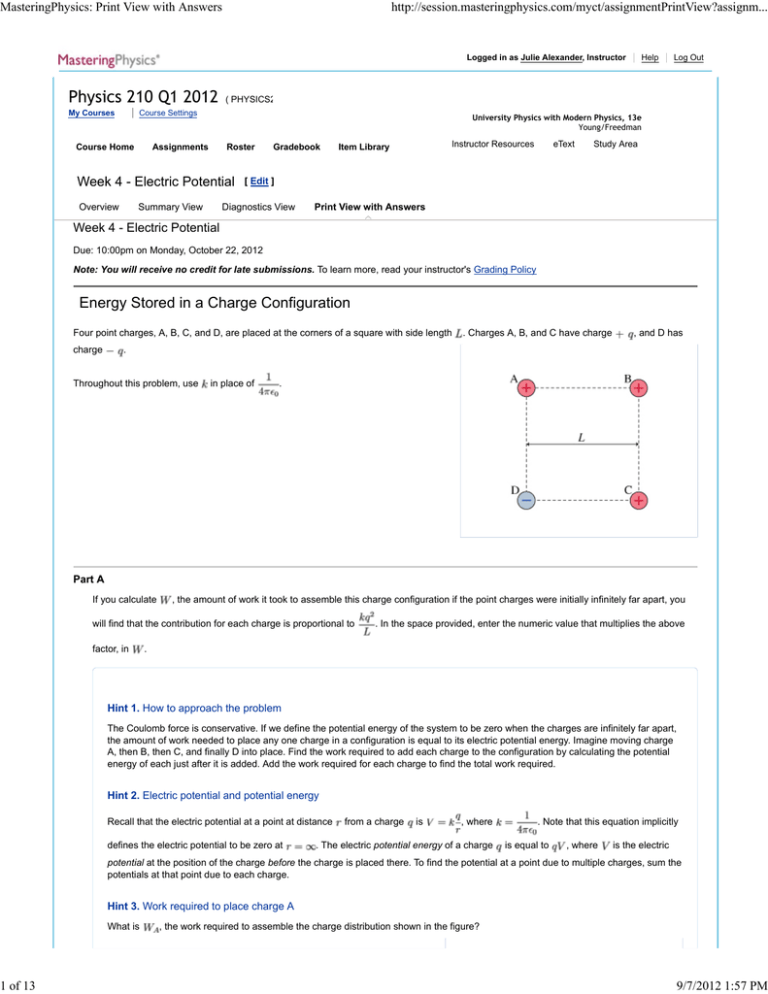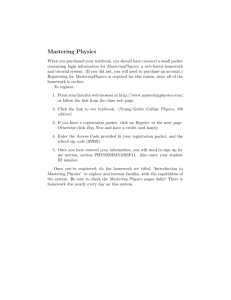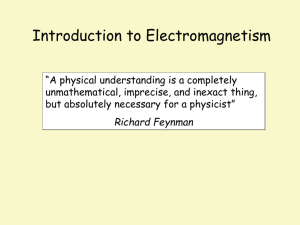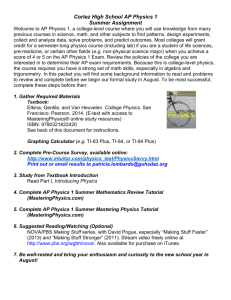MasteringPhysics: Print View with Answers
advertisement

MasteringPhysics: Print View with Answers 1 of 13 http://session.masteringphysics.com/myct/assignmentPrintView?assignm... Help Logged in as Julie Alexander, Instructor Physics 210 Q1 2012 ( PHYSICS210BRIDGE ) Course Settings My Courses Course Home University Physics with Modern Physics, 13e Young/Freedman Assignments Roster Week 4 - Electric Potential Overview Log Out Summary View Gradebook Instructor Resources Item Library eText Study Area [ Edit ] Diagnostics View Print View with Answers Week 4 - Electric Potential Due: 10:00pm on Monday, October 22, 2012 Note: You will receive no credit for late submissions. To learn more, read your instructor's Grading Policy Energy Stored in a Charge Configuration Four point charges, A, B, C, and D, are placed at the corners of a square with side length charge . Charges A, B, and C have charge , and D has . Throughout this problem, use in place of . Part A If you calculate , the amount of work it took to assemble this charge configuration if the point charges were initially infinitely far apart, you will find that the contribution for each charge is proportional to factor, in . In the space provided, enter the numeric value that multiplies the above . Hint 1. How to approach the problem The Coulomb force is conservative. If we define the potential energy of the system to be zero when the charges are infinitely far apart, the amount of work needed to place any one charge in a configuration is equal to its electric potential energy. Imagine moving charge A, then B, then C, and finally D into place. Find the work required to add each charge to the configuration by calculating the potential energy of each just after it is added. Add the work required for each charge to find the total work required. Hint 2. Electric potential and potential energy Recall that the electric potential at a point at distance defines the electric potential to be zero at from a charge is , where . The electric potential energy of a charge . Note that this equation implicitly is equal to , where is the electric potential at the position of the charge before the charge is placed there. To find the potential at a point due to multiple charges, sum the potentials at that point due to each charge. Hint 3. Work required to place charge A What is , the work required to assemble the charge distribution shown in the figure? 9/7/2012 1:57 PM MasteringPhysics: Print View with Answers 2 of 13 http://session.masteringphysics.com/myct/assignmentPrintView?assignm... Express your answer in terms of some or all of the variables , , and . Hint 1. Find the potential at the location of charge A What is , the electric potential at the upper left corner of the square before charge A is placed there? Express your answer in terms of some or all of the variables , , and . ANSWER: = 0 ANSWER: = 0 Hint 4. Work required to place charge B What is , the amount of work required to add charge B to the configuration, as shown in the figure? Express your answer in terms of some or all of the variables , , and . Hint 1. Find the potential at the location of charge B What is , the potential at the upper right corner due to charge A, before charge B is placed there? Express your answer in terms of some or all of the variables , , and . ANSWER: = 9/7/2012 1:57 PM MasteringPhysics: Print View with Answers 3 of 13 http://session.masteringphysics.com/myct/assignmentPrintView?assignm... ANSWER: = Hint 5. Work required to place charge C What is , the amount of work required to add charge C to the configuration, as shown in the figure? Express your answer in terms of some or all of the variables , , and . Hint 1. Find the potential at the location of charge C What is , the potential at the lower right corner of the square before charge C is placed there? Hint 1. How to approach this part The potential at C is the sum of the individual potentials due to the charges at B and A. Hint 2. Find the potential at C due to the charge at B What is the potential at C due to the charge at B? Express your answer in terms of some or all of the variables , , and . ANSWER: = Hint 3. Find the potential at C due to the charge at A What is the potential at C due to the charge at A? Express your answer in terms of some or all of the variables , , and . ANSWER: = . ANSWER: 9/7/2012 1:57 PM MasteringPhysics: Print View with Answers 4 of 13 http://session.masteringphysics.com/myct/assignmentPrintView?assignm... = ANSWER: = Hint 6. Find the work required to place charge D What is , the amount of work required to add charge D to the configuration? Express your answer in terms of some or all of the variables , , and . Hint 1. Find the potential at the position of charge D What is , the potential at the lower left corner of the square before charge D is placed there? Express your answer in terms of some or all of the variables , , and . ANSWER: = ANSWER: = Because D has a negative charge, it is attracted to charges A, B, and C. This accounts for the negative sign on the work. We would have to do positive work to remove charge D from the configuration. ANSWER: = 0 9/7/2012 1:57 PM MasteringPhysics: Print View with Answers 5 of 13 http://session.masteringphysics.com/myct/assignmentPrintView?assignm... The hints led you through the problem by adding one charge at a time. A little thought shows that this is equivalent to simply adding the energies of all possible pairs: . Note that this is not equivalent to adding the potential energies of each charge. Adding the potential energies will give you double the correct answer because you will be counting each charge twice. Part B Which of the following figures depicts a charge configuration that requires less work to assemble than the configuration in the problem introduction? Assume that all charges have the same magnitude . ANSWER: figure a figure b figure c Moving a Charge Part A A point charge with charge ( 0.170 = 2.10 , 0) to the point ( 0.255 is held stationary at the origin. A second point charge with charge , 0.275 Express your answer in joules. Use ). How much work = 8.99×10 9 = -4.10 moves from the point is done by the electric force on the moving point charge? for Coulomb's constant: . Hint 1. How to approach the problem Use the equation for the electric potential energy between two point charges to calculate the work done by the electric force. Recall that the work done by a conservative force is , the difference between the initial and final potential energies. A conservative force is one for which the work done on a particle by the force is independent of the path taken and depends only on the initial and final points. The electric force is a conservative force. Gravity is another example of a conservative force. Hint 2. Calculate the initial electric potential energy Calculate the initial electric potential energy Express your answer in joules. Use when the moving point charge is at the point ( 0.170 9 = 8.99×10 for Coulomb's constant: , 0). . 9/7/2012 1:57 PM MasteringPhysics: Print View with Answers 6 of 13 http://session.masteringphysics.com/myct/assignmentPrintView?assignm... Hint 1. Derivation of electric potential energy The force between two point charges the charges and point and is given by Coulomb's law as , where is the separation between . The work done by the electric force between the charges as one charge moves from point and the other is held fixed is calculated using to . Since the force depends only on the distance between the charges, it follows that , where and are the distances between the fixed charge and points and , respectively. Since the work done is equal to the change in potential energy, this equation is consistent with defining the electric potential energy between two point charges a distance apart by . ANSWER: = -0.455 = Hint 3. Calculate the final electric potential energy Calculate the final electric potential energy Express your answer in joules. Use when the moving charge is at the point ( 0.255 9 = 8.99×10 for Coulomb's constant: , 0.275 ). . Hint 1. Derivation of electric potential energy The force between two point charges the charges and point and is given by Coulomb's law as , where is the separation between . The work done by the electric force between the charges as one charge moves from point and the other is held fixed is calculated using to . Since the force depends only on the distance between the charges, it follows that , where and are the distances between the fixed charge and points and , respectively. Since the work done is equal to the change in potential energy, this equation is consistent with defining the electric potential energy between two point charges a distance apart by . ANSWER: = = -0.206 ANSWER: 9/7/2012 1:57 PM MasteringPhysics: Print View with Answers 7 of 13 http://session.masteringphysics.com/myct/assignmentPrintView?assignm... = -0.249 = Also accepted: = -0.249 Exercise 23.5 A small metal sphere, carrying a net charge of with a net charge of speed 22.0 = -7.20 = -2.50 , is held in a stationary position by insulating supports. A second small metal sphere, and mass 1.80 , is projected toward . When the two spheres are 0.800 apart, is moving toward with . Assume that the two spheres can be treated as point charges. You can ignore the force of gravity. Part A What is the speed of when the spheres are 0.400 apart? ANSWER: = 16.1 = Part B How close does get to ? ANSWER: = = 0.254 Exercise 23.13 A small particle has charge -3.30 where the electric potential particle has a speed of 3.40 and mass 2.00×10 = 520 −4 . It moves from point is greater than the potential at point at point , where the electric potential is = 250 , to point , . The electric force is the only force acting on the particle. The . Part A What is its speed at point ? ANSWER: 9/7/2012 1:57 PM MasteringPhysics: Print View with Answers 8 of 13 http://session.masteringphysics.com/myct/assignmentPrintView?assignm... = 4.52 = Part B Is it moving faster or slower at than at ? ANSWER: Faster Slower Exercise 23.19 Two point charges from = 2.10 and = -6.90 are 0.100 apart. Point is midway between them; point is 0.080 from and 0.060 (the figure ). Take the electric potential to be zero at infinity. Part A Find the potential at point . ANSWER: = = -863 Part B Find the potential at point . ANSWER: = = -798 9/7/2012 1:57 PM MasteringPhysics: Print View with Answers 9 of 13 http://session.masteringphysics.com/myct/assignmentPrintView?assignm... Part C Find the work done by the electric field on a charge of 2.80 that travels from point to point . Express your answer using two significant figures. ANSWER: = 1.8×10−7 = Exercise 23.24 At a certain distance from a point charge, the potential and electric field magnitude due to that charge are 4.98 and 12.0 , respectively. (Take the potential to be zero at infinity.) Part A What is the distance to the point charge? ANSWER: = 0.415 Part B What is the magnitude of the charge? ANSWER: = 2.30×10−10 Part C Is the electric field directed toward or away from the point charge? ANSWER: Toward Away Exercise 23.25 A uniform electric field has magnitude point (at 0.80 ) is 350 and is directed in the negative direction. The potential difference between point (at 0.70 ) and . Part A Which point, or , is at the higher potential? ANSWER: a b Part B 9/7/2012 1:57 PM MasteringPhysics: Print View with Answers 10 of 13 Calculate the value of http://session.masteringphysics.com/myct/assignmentPrintView?assignm... . Express your answer using two significant figures. ANSWER: = = 3500 Part C A negative point charge is moved from to . Calculate the work done on the point charge by the electric field. Express your answer using two significant figures. ANSWER: = −7.0×10−5 = Exercise 23.45 In a certain region of space, the electric potential is , where , , and are positive constants. Part A Calculate the -component of the electric field. Express your answer in terms of the given quantities. ANSWER: = Part B Calculate the -component of the electric field. Express your answer in terms of the given quantities. ANSWER: = Part C Calculate the -component of the electric field. Express your answer in terms of the given quantities. ANSWER: = 0 Part D At which point is the electric field equal to zero? ANSWER: 9/7/2012 1:57 PM MasteringPhysics: Print View with Answers 11 of 13 http://session.masteringphysics.com/myct/assignmentPrintView?assignm... Problem 23.62 A small sphere with mass 1.60 hangs by a thread between two large parallel vertical plates 5.00 uniform surface charge densities 9.80×10 −6 and . The charge on the sphere is apart . The plates are insulating and have = . Part A What potential difference between the plates will cause the thread to assume an angle of 30.0 with the vertical? ANSWER: = = 46.2 Problem 23.83 A metal sphere with radius has a charge . Take the electric potential to be zero at an infinite distance from the sphere. Part A What is the electric field at the surface of the sphere? Express your answer in terms of the given quantities and appropriate constants. ANSWER: = Also accepted: , Part B What is the electric potential at the surface of the sphere? Express your answer in terms of the given quantities and appropriate constants. ANSWER: 9/7/2012 1:57 PM MasteringPhysics: Print View with Answers 12 of 13 http://session.masteringphysics.com/myct/assignmentPrintView?assignm... = Also accepted: , Part C This sphere is now connected by a long, thin conducting wire to another sphere of radius that is several meters from the first sphere. Before the connection is made, this second sphere is uncharged. After electrostatic equilibrium has been reached, what is the total charge on each sphere? Assume that the amount of charge on the wire is much less than the charge on each sphere. Express your answer in terms of the given quantities and appropriate constants. ANSWER: = Part D Express your answer in terms of the given quantities and appropriate constants. ANSWER: = Part E What is the electric potential at the surface of each sphere? Assume that the amount of charge on the wire is much less than the charge on each sphere. Express your answer in terms of the variables , , and appropriate constants. , , and appropriate constants. ANSWER: = Also accepted: , Part F Express your answer in terms of the variables ANSWER: = Also accepted: , Part G What is the electric field at the surface of each sphere? Assume that the amount of charge on the wire is much less than the charge on each sphere. Express your answer in terms of the variables , , and appropriate constants. 9/7/2012 1:57 PM MasteringPhysics: Print View with Answers 13 of 13 http://session.masteringphysics.com/myct/assignmentPrintView?assignm... ANSWER: = Also accepted: , Part H Express your answer in terms of the variables , , and appropriate constants. ANSWER: Also accepted: , Copyright © 2012 Pearson. All rights reserved. Legal Notice Privacy Policy Permissions Support 9/7/2012 1:57 PM



